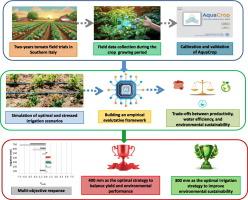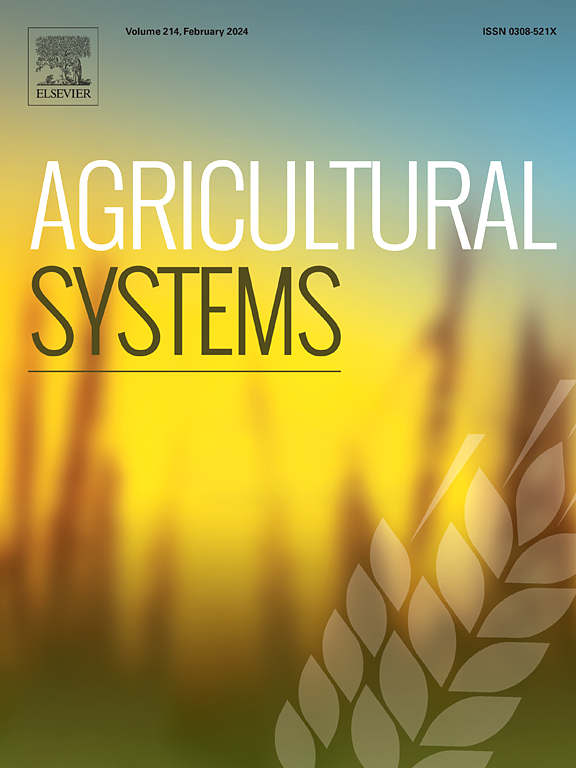AquaCrop model to optimize water supply for a sustainable processing tomato cultivation in the Mediterranean area: A multi-objective approach
IF 6.1
1区 农林科学
Q1 AGRICULTURE, MULTIDISCIPLINARY
引用次数: 0
Abstract
CONTEXT
Efficient irrigation management must consider multiple aspects of cropping systems, such as productivity, water use efficiency, and economic viability. Crop simulation models like AquaCrop are essential tools for analyzing crop responses under different irrigation scenarios. Organizing the model's outputs into standardized parameters allows for a multi-objective evaluation, which can be consolidated into a single index for optimizing irrigation strategies.
OBJECTIVE
This study aims to formalize the response of processing tomato cropping systems in Southern Italy to various irrigation regimes and develop a framework to identify optimal irrigation volumes for production, water use efficiency, and economic returns.
METHODS
AquaCrop was used to assess the effects of different seasonal water supplies on dry yield, water use efficiency, and irrigation water use efficiency. Sustainability was evaluated via the blue water footprint and drainage, while economic sustainability was measured through net income and irrigation economic efficiency. A multi-objective evaluation framework was built, developed to consolidate performance indices into a single multi-aggregated index (Imobj). The AquaCrop model was calibrated and validated using field data, with high accuracy in simulating canopy cover, biomass, and dry yield (NRMSE < 30 %, r > 0.90, and d > 0.97). Polynomial regression was used to model the relationships between irrigation volumes and cropping system variables. Each variable was assigned a truth value (TWi), derived from regression coefficients, statistical significance, and model fit. These values were normalized using a sigmoid function and consolidated into the Imobj index, providing an overall measure of irrigation performance.
RESULTS AND CONCLUSIONS
AquaCrop accurately simulated canopy cover, biomass, and dry yield. Multi-objective analysis showed yield and profitability were most sensitive to irrigation changes, followed by drainage, blue water footprint, and water use efficiency. The 500 mm irrigation regime yielded the highest productivity and profitability but negatively impacted water use efficiency and environmental sustainability. Irrigation volumes above 500 mm worsened all water-related variables, while volumes of 400 mm reduced profitability but improved the sustainability. The Imobj index identified that irrigation between 300 mm and 400 mm provided the best trade-off across all evaluated variables.
SIGNIFICANCE
This study highlights the value of integrating crop productivity, economic viability, and sustainability into irrigation management. The proposed framework, combined with AquaCrop, offers a holistic tool for optimizing irrigation strategies in agriculture. It emphasizes the need for balanced irrigation that not only maximizes yield but also enhances resource efficiency and environmental sustainability.

AquaCrop 模型用于优化地中海地区番茄可持续加工种植的供水:多目标方法
内容提要有效的灌溉管理必须考虑作物系统的多个方面,如生产力、用水效率和经济可行性。AquaCrop 等作物模拟模型是分析不同灌溉方案下作物反应的重要工具。本研究旨在正式确定意大利南部加工番茄种植系统对各种灌溉制度的反应,并制定一个框架,以确定产量、用水效率和经济收益的最佳灌溉量。方法使用 AquaCrop 评估不同季节供水对干产量、用水效率和灌溉用水效率的影响。可持续性通过蓝水足迹和排水量进行评估,而经济可持续性则通过净收入和灌溉经济效益进行衡量。建立了一个多目标评价框架,旨在将绩效指数整合为一个单一的多综合指数(Imobj)。利用田间数据对 AquaCrop 模型进行了校准和验证,该模型在模拟冠层覆盖率、生物量和干产量方面具有很高的准确性(NRMSE < 30 %,r > 0.90,d > 0.97)。多项式回归用于模拟灌溉量与种植系统变量之间的关系。根据回归系数、统计显著性和模型拟合度,为每个变量分配一个真值 (TWi)。这些值使用 sigmoid 函数进行归一化处理,并合并到 Imobj 指数中,从而提供了灌溉性能的总体衡量标准。结果与结论AquaCrop 准确模拟了冠层覆盖率、生物量和干产量。多目标分析表明,产量和收益率对灌溉变化最敏感,其次是排水、蓝水足迹和用水效率。500 毫米灌溉量的产量和收益率最高,但对用水效率和环境可持续性产生了负面影响。500 毫米以上的灌溉量使所有与水有关的变量恶化,而 400 毫米的灌溉量则降低了收益率,但改善了可持续性。Imobj 指数表明,300 毫米至 400 毫米之间的灌溉量是所有评估变量中的最佳权衡指标。 意义本研究强调了将作物生产力、经济可行性和可持续性纳入灌溉管理的价值。所提出的框架与 AquaCrop 相结合,为优化农业灌溉策略提供了一个整体工具。它强调了平衡灌溉的必要性,不仅能实现产量最大化,还能提高资源效率和环境可持续性。
本文章由计算机程序翻译,如有差异,请以英文原文为准。
求助全文
约1分钟内获得全文
求助全文
来源期刊

Agricultural Systems
农林科学-农业综合
CiteScore
13.30
自引率
7.60%
发文量
174
审稿时长
30 days
期刊介绍:
Agricultural Systems is an international journal that deals with interactions - among the components of agricultural systems, among hierarchical levels of agricultural systems, between agricultural and other land use systems, and between agricultural systems and their natural, social and economic environments.
The scope includes the development and application of systems analysis methodologies in the following areas:
Systems approaches in the sustainable intensification of agriculture; pathways for sustainable intensification; crop-livestock integration; farm-level resource allocation; quantification of benefits and trade-offs at farm to landscape levels; integrative, participatory and dynamic modelling approaches for qualitative and quantitative assessments of agricultural systems and decision making;
The interactions between agricultural and non-agricultural landscapes; the multiple services of agricultural systems; food security and the environment;
Global change and adaptation science; transformational adaptations as driven by changes in climate, policy, values and attitudes influencing the design of farming systems;
Development and application of farming systems design tools and methods for impact, scenario and case study analysis; managing the complexities of dynamic agricultural systems; innovation systems and multi stakeholder arrangements that support or promote change and (or) inform policy decisions.
 求助内容:
求助内容: 应助结果提醒方式:
应助结果提醒方式:


